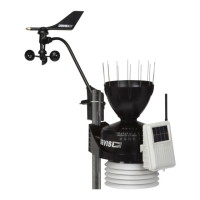Configuring the Wireless ISS Page 3
C
ONFIGURING
THE
W
IRELESS
ISS
Both the transmitter in the ISS and the receiver in the console have ID codes.
These ID codes enable a specific transmitter to “talk to” a specific receiver, even
if many transmitters are operating in the same area.
Setting the ID Code
The ISS may be set to use any of eight selectable ID codes (the default is ID
Code #1). The ISS and console/receiver will only communicate with each
other if they are both set to the same ID code. Use the default setting unless
you have another Davis wireless weather station operating nearby which you
want to work separately from the new system. The dip switch settings for the
eight possible codes are shown below.
To change to another ID, toggle dip switches 1, 2, and/or 3 on the ISS and then
set the console/receiver’s ID code to match. Remember that the ISS and con-
sole/receiver must use the same ID code in order to communicate.
Note:
Dip switch #4 is used for testing only, not for ID codes. See details below.
Test Mode
Dip switch #4 on the ISS allows you to configure the Test LED to flash when-
ever a data packet is transmitted. This feature allows you to more easily set up
and test your transmitting system. When you are done setting up or testing,
however, make sure you
turn dip switch #4 to OFF so that the LED does not flash
and waste significant amounts of power unnecessarily
.
ID C
ODE
D
IP
S
WITCH
1D
IP
S
WITCH
2D
IP
S
WITCH
3
#1
(default)
off off off
#2
off off ON
#3
off ON off
#4
off ON ON
#5
ON off off
#6
ON off ON
#7
ON ON off
#8
ON ON ON

